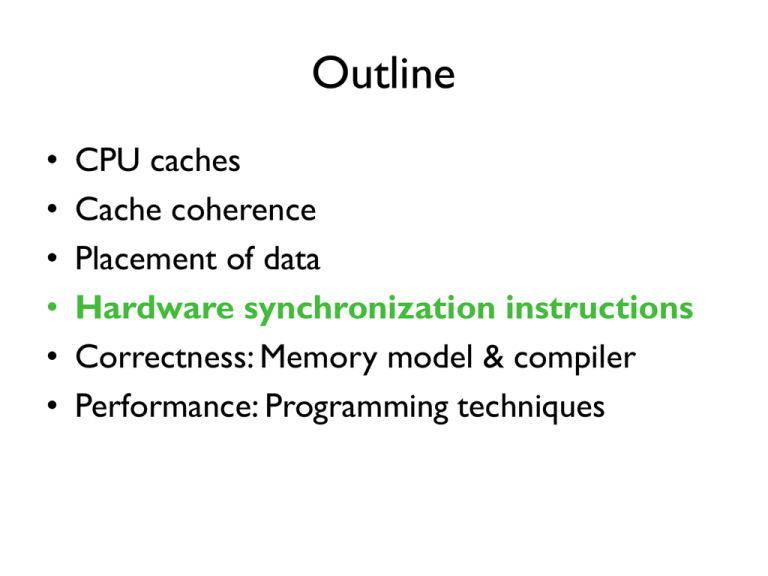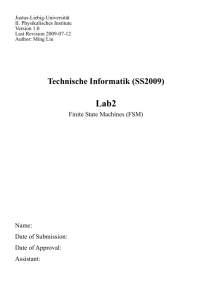Hardware synchronization instructions
advertisement

Outline
•
•
•
•
•
•
CPU caches
Cache coherence
Placement of data
Hardware synchronization instructions
Correctness: Memory model & compiler
Performance: Programming techniques
The Programmer’s Toolbox:
Hardware Synchronization Instructions
• Depends on the processor;
• CAS generally provided;
• Test-and-Set and Fetch-and-Increment etc. may
or may not be provided;
• x86:
– Atomic exchange, increment, decrement provided
– Memory barrier also available
• New Intels (Haswell) provide transactional
memory
Example: Atomic Ops in GCC
type __sync_fetch_and_OP(type *ptr,
type __sync_OP_and_fetch(type *ptr,
// OP in {add,sub,or,and,xor,nand}
type value);
type value);
type __sync_val_compare_and_swap(type *ptr, type
oldval, type newval);
bool __sync_bool_compare_and_swap(type *ptr, type
oldval, type newval);
__sync_synchronize(); // memory barrier
Intel’s Transactional Synchronization
Extensions (TSX)
1. Hardware lock elision (HLE)
• Instruction prefixes:
XACQUIRE
XRELEASE
Ex:
__hle_{acquire,release}_compare_exchange_n{1,2,4,8}
• Try to execute critical sections without
acquiring/releasing the lock.
• If conflict detected, abort and acquire the lock before
re-doing the work
Intel’s Transactional Synchronization
Extensions (TSX)
2. Restricted Transactional Memory (RTM)
_xbegin();
_xabort();
_xtest();
_xend();
Not starvation free!
Transactions can be aborted for a variety of reasons.
Should have a non-transactional back-up.
Limited transaction size.
Intel’s Transactional Synchronization
Extensions (TSX)
2. Restricted Transactional Memory (RTM)
Example:
if (_xbegin() == _XBEGIN_STARTED){
counter = counter + 1;
_xend();
} else {
__sync_fetch_and_add(&counter,1);
}
Outline
•
•
•
•
•
•
CPU caches
Cache coherence
Placement of data
Hardware synchronization instructions
Correctness: Memory model & compiler
Performance: Programming techniques
Concurrent Algorithm Correctness
• Designing correct concurrent algorithms:
1. Theoretical part
2. Practical part
• The processor and compiler optimize
assuming no concurrency!
The Memory Consistency Model
//A, B shared variables, initially 0;
//r1, r2 – local variables;
P1
P2
A = 1;
r1 = B;
B = 1;
r2 = A;
What values can r1 and r2 take?
(assume x86 processor)
Answer:
(0,1), (1,0), (1,1) and (0,0)
The Memory Consistency Model
• The order in which memory instructions
appear to execute
– What would the programmer like to see?
• Sequential consistency
– All operations executed in some sequential order;
– Memory operations of each thread in program
order;
– Intuitive, but limits performance;
The Memory Consistency Model
How can the processor reorder instructions to
different memory addresses?
x86 (Intel, AMD): TSO variant
• Reads not reordered w.r.t. reads
• Writes not reordered w.r.t writes
• Writes not reordered w.r.t. reads
• Reads may be reordered w.r.t. writes
to different memory addresses
//A,B,C
//globals
…
int x,y,z;
x = A;
y = B;
B = 3;
A = 2;
y = A;
C = 4;
z = B;
…
The Memory Consistency Model
• Single thread – reorderings transparent;
• Avoid reorderings: memory barriers
– x86 – implicit in atomic ops;
– “volatile” in Java;
– Expensive - use only when really necessary;
• Different processors – different memory
consistency models
– e.g., ARM – relaxed memory model (anything goes!);
– VMs (e.g. JVM, CLR) have their own memory models;
Beware of the Compiler
void lock(int * some_lock) {
while (CAS(some_lock,0,1) != 0) {}
} asm volatile(“” ::: “memory”); //compiler barrier
void unlock(int * some_lock) {
}
void*some_lock
unlock(int= *0;some_lock) {
} asm volatile(“” ::: “memory”); //compiler barrier
*some_lock = 0;
}
int the_lock=0;
volatile
int the_lock=0;
lock(&the_lock);
…
unlock(&the_lock);
C ”volatile” !=
Java “volatile”
• The compiler can:
• reorder
• remove instructions
• not write values to memory
Outline
•
•
•
•
•
•
CPU caches
Cache coherence
Placement of data
Hardware synchronization instructions
Correctness: Memory model & compiler
Performance: Programming techniques
Concurrent Programming Techniques
• What techniques can we use to speed up our
concurrent application?
• Main idea: minimize contention on cache lines
• Use case: Locks
– acquire()
– release()
Let’s start with a simple lock…
Test-and-Set Lock
typedef volatile uint lock_t;
void acquire(lock_t * some_lock) {
while (TAS(some_lock) != 0) {}
asm volatile(“” ::: “memory”);
}
void release(lock_t * some_lock) {
asm volatile(“” ::: “memory”);
*some_lock = 0;
}
How good is this lock?
• A simple benchmark
• Have 48 threads continuously acquire a lock,
update some shared data, and unlock
• Measure how many operations we can do in a
second
• Test-and-Set lock: 190K operations/second
How can we improve things?
Avoid cache-line ping-pong:
Test-and-Test-and-Set Lock
void acquire(lock_t * some_lock) {
while(1) {
while (*some_lock != 0) {}
if (TAS(some_lock) == 0) {
return;
}
}
asm volatile(“” ::: “memory”);
}
void release(lock_t * some_lock) {
asm volatile(“” ::: “memory”);
*some_lock = 0;
}
Performance comparison
400
Ops/second (thousands)
350
300
250
200
150
100
50
0
Test-and-Set
Test-and-Test-and-Set
But we can do even better
Avoid thundering herd:
Test-and-Test-and-Set with Back-off
void acquire(lock_t * some_lock) {
uint backoff = INITIAL_BACKOFF;
while(1) {
while (*some_lock != 0) {}
if (TAS(some_lock) == 0) {
return;
} else {
lock_sleep(backoff);
backoff=min(backoff*2,MAXIMUM_BACKOFF);
}
}
asm volatile(“” ::: “memory”);
}
void release(lock_t * some_lock) {
asm volatile(“” ::: “memory”);
*some_lock = 0;
}
Performance comparison
Ops/second (thousands)
800
700
600
500
400
300
200
100
0
Test-and-Set
Test-and-Test-and-Set Test-and-Test-and-Set
w. backoff
Are these locks fair?
Processed requests per thread,Test-and-Set lock
35000
Number of processed requests
30000
25000
20000
15000
10000
5000
0
1 2 3 4 5 6 7 8 9 10 11 12 13 14 15 16 17 18 19 20 21 22 23 24 25 26 27 28 29 30 31 32 33 34 35 36 37 38 39 40 41 42 43 44 45 46 47 48
Thread number
What if we want fairness?
Use a FIFO mechanism:
Ticket Locks
typedef ticket_lock_t {
volatile uint head;
volatile uint tail;
} ticket_lock_t;
void acquire(ticket_lock_t * a_lock) {
uint my_ticket = fetch_and_inc(&(a_lock->tail));
while (a_lock->head != my_ticket) {}
asm volatile(“” ::: “memory”);
}
void release(ticket_lock_t * a_lock) {
asm volatile(“” ::: “memory”);
a_lock->head++;
}
What if we want fairness?
Processed requests per thread,Ticket Locks
35000
Number of processed requests
30000
25000
20000
15000
10000
5000
0
1 2 3 4 5 6 7 8 9 10 11 12 13 14 15 16 17 18 19 20 21 22 23 24 25 26 27 28 29 30 31 32 33 34 35 36 37 38 39 40 41 42 43 44 45 46 47 48
Thread number
Ops/second (thousands)
Performance comparison
800
700
600
500
400
300
200
100
0
Can we back-off here as well?
Yes, we can:
Proportional back-off
void acquire(ticket_lock_t * a_lock) {
uint my_ticket = fetch_and_inc(&(a_lock->tail));
uint distance, current_ticket;
while (1) {
current_ticket = a_lock->head;
if (current_ticket == my_ticket) break;
distance = my_ticket – current_ticket;
if (distance > 1)
lock_sleep(distance * BASE_SLEEP);
}
asm volatile(“” ::: “memory”);
}
void release(ticket_lock_t * a_lock) {
asm volatile(“” ::: “memory”);
a_lock->head++;
}
Ops/second (thousands)
Performance comparison
1600
1400
1200
1000
800
600
400
200
0
Still, everyone is spinning on the same
variable….
Use a different address for each thread:
Queue Locks
1
2
leaving
run
run
spin
3
4
spin
arriving
spin
Use with moderation: storage overheads
Ops/second (thousands)
2000
1800
1600
1400
1200
1000
800
600
400
200
0
Performance comparison
To sum it up
•
•
•
•
Reading before trying to write
Pausing when it’s not our turn
Ensuring fairness
Accessing disjoint addresses (cache lines)
More than 10x performance gain!
Conclusion
• Concurrent algorithm design:
– Theoretical design
– Practical design (may be just as important)
• You need to know your hardware
– For correctness
– For performance
Reminder
Programming assignments due next Tuesday!
If you have any questions,
attend today’s exercise session








